7 Small Room Ideas That Work Big
Looking for some ideas to help with a small room? It’s no surprise. Small room design can be really challenging, but it doesn’t have to be.
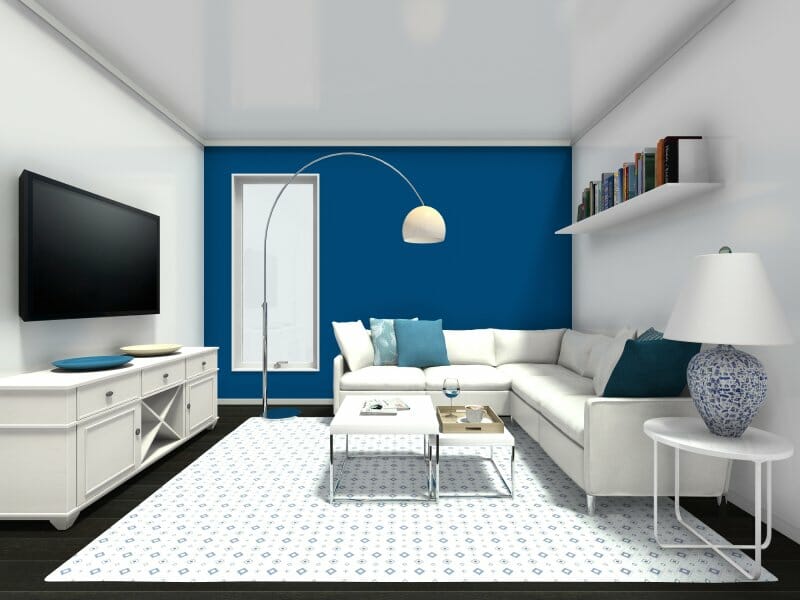
With a little help, you can make your small rooms feel bright and inviting. The trick is knowing what works for small rooms and what doesn’t. In this article, we’ll show you small room ideas that work and how to implement them in your own home.
So, are you ready to make your small rooms feel bigger? Great, let’s go.
1. Go with the Flow
In any well-designed room, traffic flow is important. In a small room design, it’s critical. With large rooms, the key is to control and direct traffic flow. In small rooms there are fewer options, so get to know the flow of your room and work with it. The concept is simple: Your ability to move around a room comfortably affects your perception of it. When you can move around a room unhindered, it’s a nicer place to be.
Here are a few tips that will help you improve the flow in your small room:
- Avoid Swerving – Keep large furniture away from the doorways and out of path of movement. Just like on the road, in small rooms you want to avoid swerving. For example place long furniture along the long walls i.e. with the flow.
- Define Boundaries – Create clear zones. Use walls and large furniture to define the outside edges of your zones. For inside edges, use smaller furniture such as chairs, low tables and carpets to create definition.
- Create a Visible Path – Keep the pathway in and out of your room clear and visible. Allow movement and remove any roadblocks.

The small living area above has to provide two functions – dining and living. By aligning the large furniture along the far walls, the path to each area becomes clear and unobstructed. This makes the seating and dining areas easier to access and more inviting.
2. Create Smaller Usable Areas
This may sound contradictory for small room design. However as the small living area above illustrates, a small room does not have to have only one function. The key is to define the zones clearly and to make sure they do not disrupt the flow of the room. In fact, in long narrow spaces, creating two zones can actually help to balance the room.
In the room above, the seating area is defined by the area rug. The rug is similar in color to the floor. This helps the room feel open and unobstructed. Yet, the change in texture still defines the zone and makes it more inviting.
When making several zones in a small room remember – simplicity works best. Give each zone a clear purpose and keep decorative elements to a minimum. Use artwork to create a focal point for each zone and a single accent color to tie it all together.
3. Go Bold – Using Color in Small Rooms
There are conflicting opinions on how to use color in small rooms. One opinion is that walls that are white or light in color will make a room seem larger. However, some experts argue, that bold colors can also make a small room feel larger. The reasoning behind this? Bold colors define boundaries better than light colors and people tend to feel more comfortable in well-defined spaces.
The truth is, both are correct. Whether you prefer light or bold color schemes, the key is to make the room feel well-defined. Above, we showed ideas to define a small room with a light color scheme. Now, let’s look at how to do the same thing with bold colors.
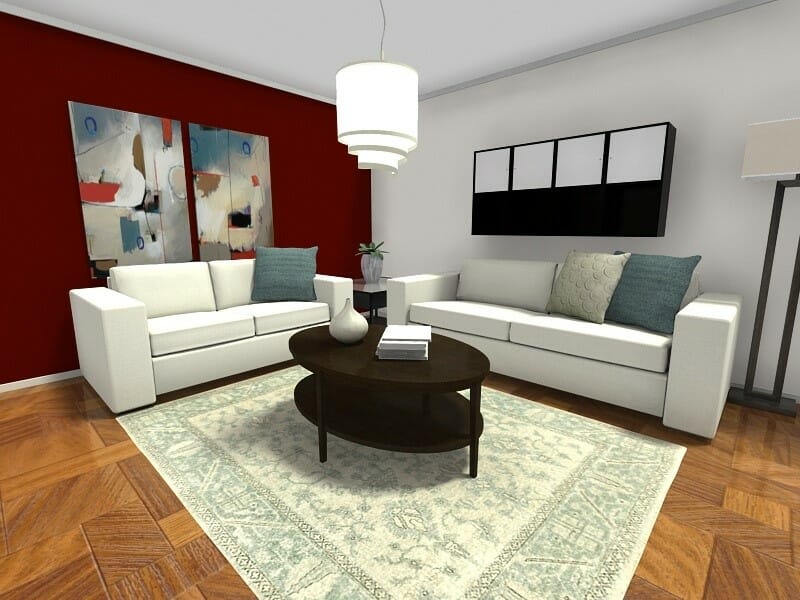
One technique is to create a bold-colored accent wall. This is an excellent way to create a focal point in a room. For small rooms, you want to place your focal point on the far wall. This adds depth and draws you into the space. Then use furniture and accessories in a complementary color to tie the look together.
The second technique is to go bold throughout. Dark-colored walls actually expand a room visually, while still creating an inviting coziness. This is a great technique for small interior rooms such as powder rooms, dens, libraries, and hallways.
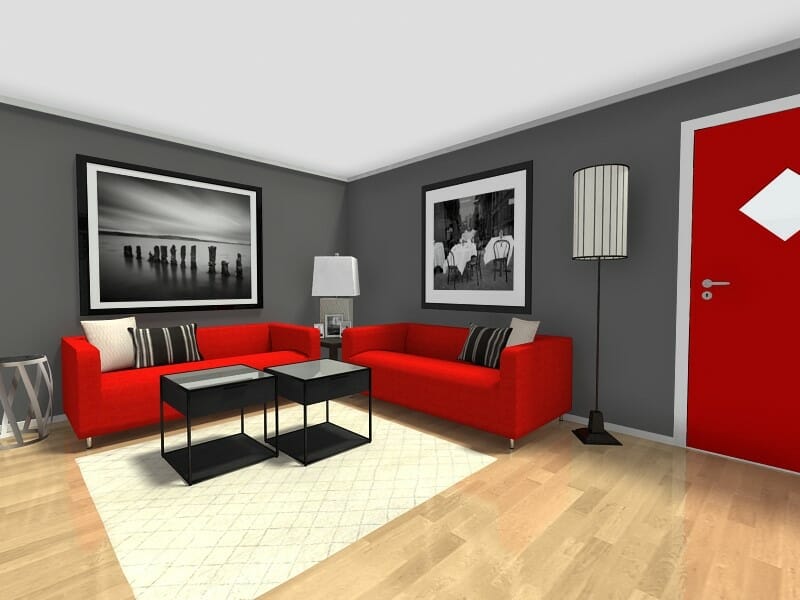
The example above illustrates how this idea can be used in a small room. The dark gray walls create a well-defined boundary, while the color red is used to create clear focal points. The result – a well-defined room that still feels open.
4.Create Balance and Symmetry
Everyone loves a little quirkiness in a room, but if you want to make a small room bigger – avoid asymmetry. We’ve learned that people like well-defined spaces – especially in small rooms. Once you have created the basic layout and traffic flow for your small room, look for ways to add balance and symmetry. Work in pairs, for example, a pair of matching sofas to define a seating area OR one sofa with a pair of matching chairs on either side.
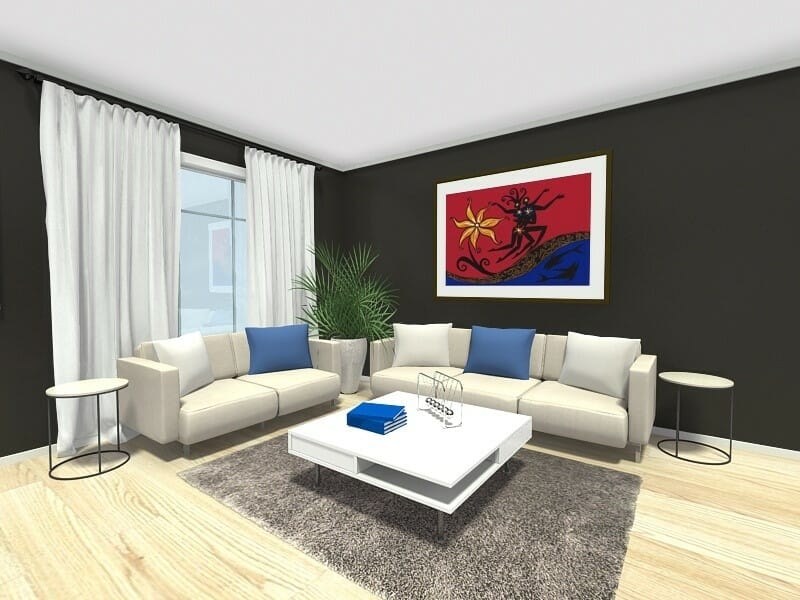
You can create symmetry and balance in your small room with furniture, artwork, and color.
Don’t forget to keep the colors of your floor and ceiling in mind. A light-colored ceiling and floor will make a small room feel bigger. Dark ceilings will make a small room feel more cozy and intimate. Dark floors will draw the eye downward. If your floors are dark, create balance with either light-colored walls, a light-colored carpet, or a bold accent wall.
5. Use Multi-Purpose Furniture
Your small room may not be big on square footage, but it can be big on comfort. The trick is to transform your room from cluttered to spacious while keeping it comfortable AND functional. One of the best ways to do this is with multi-purpose furniture.
For seating areas, look for sofas with storage or that can transform into a bed. Small items such as ottomans or stools can double as a coffee table, side table, and extra seating.
In a small kitchen, replace the table and chairs with a counter-height table and stools that can provide extra prep space, while still providing a place to dine and hang out.
For a small bedroom, look for a bed that has built-in storage or bookcases, a vanity table that can double as a desk (or visa-versa), and a wardrobe with built-in drawers to eliminate the need for a dresser.
6. Think Vertical
When we think about usable space, we tend to focus on floor space. However, if the ceilings in your small room are not too low – think vertical! And take advantage of available wall space for storage.
Keep in mind that the goal is to add functionality while keeping your small room open. Here are some tips to add storage, while keeping things comfortable, livable and clutter-free:
- Tall furniture can overwhelm a small room, so keep tall pieces to a minimum.
- Try a well-placed bookshelf or a group of staggered open shelves on the wall.
- Swap side tables and table lamps for standing lamps to open up the room.
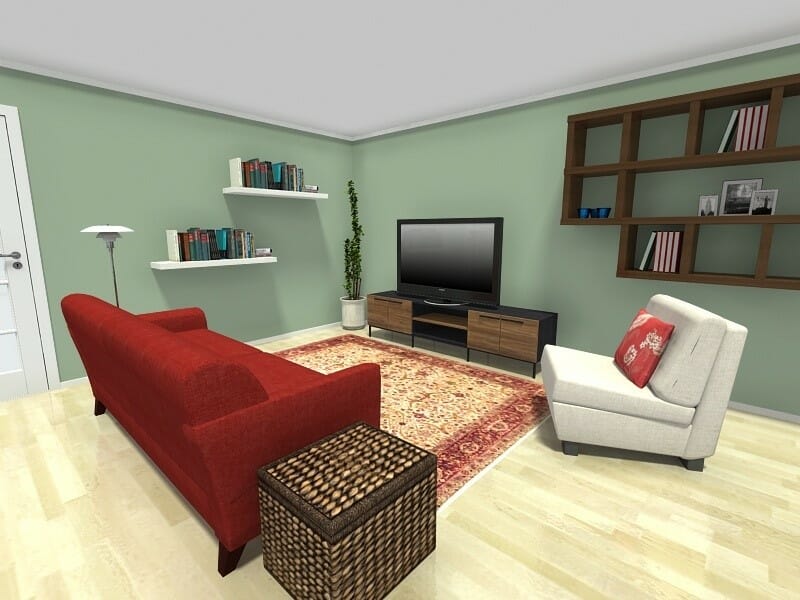
In the small room above, the wall shelves provide storage and a place for small items. They are also decorative and add balance and symmetry to the room.
7. Decorate Wisely
Just as different color schemes can influence how we see a room, so can decoration. The things we put on our walls, tables, and countertops matter, and they can help your small room look larger.
A classic small room idea is to add a mirror or two on your walls. This small room design trick has been used for ages and it always works. Mirrors bounce light and they extend a room visually, which is particularly useful for small rooms.
Believe it or not, large-scale artwork can do the same thing—as long as the color palette works with the design of your room. You can use artwork to create a focal point, to add definition, as well as depth to a small room.

In the room above, you can see how the landscape painting complements the windows and adds to the open feeling in this small room.
Keep the number of accent colors to a minimum – two is a good rule of thumb. And include sculptural elements such as lighting, plants, and a round ottoman or curved accent chair to break up rectangular lines. These decorative items are functional and provide visual interest. A small room that is well-defined and visually interesting will both stimulate the mind and feel less claustrophobic – which is the goal, right?
Try It in Your Home
To figure out which small room ideas and design strategies will work best in your home, try using the RoomSketcher App.
Don't forget to share this post!
Recommended Reads

6 Simple Steps to Achieve the Best Furniture Layout
Today, we’ll discuss some ideas for creating the best possible furniture layout and how you can try out your furniture placement ideas without the heavy lifting!
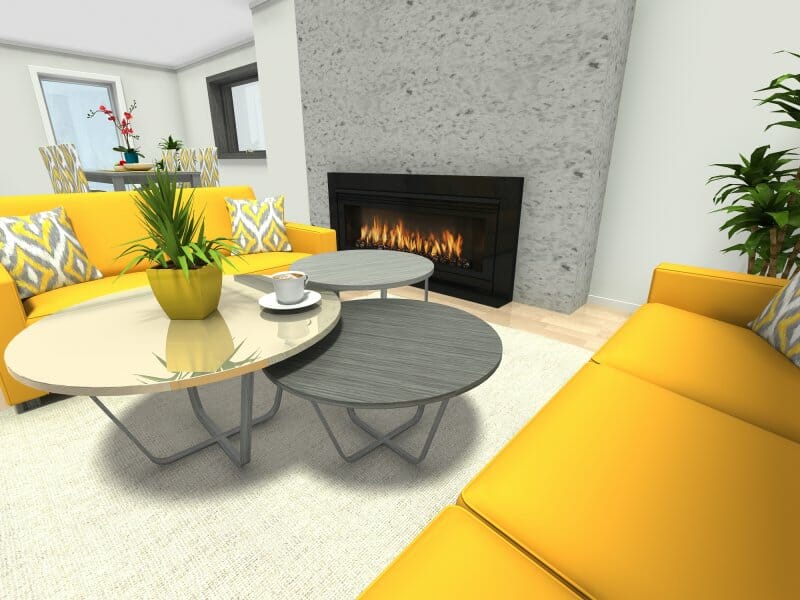
Small Living Room Layout - 8 Design Tips
Need help with a small or narrow living room layout? Get expert tips on how to make your small living room layout functional and inviting.

5 Downsizing Tips for Small Apartment Life
Downsizing to a smaller apartment can be extremely difficult. These Top 5 Downsizing Tips from the experts at Adobo can help. Check it out!
